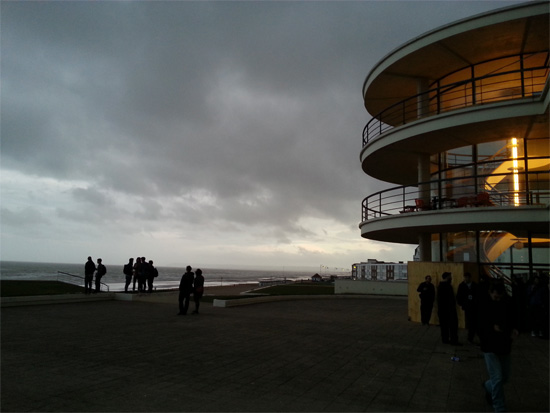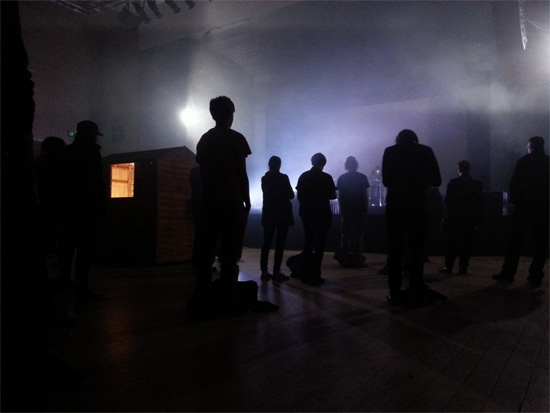Of all the places to end up for a day-long celebration of digital electronic extremes, musique concrete and funked-up rave abstraction, you could be forgiven for finding Bexhill-On-Sea somewhat incongruous. Meandering down the gradual incline from the train station towards the sea, what’s striking from the perspective of a group of Londoners who just two hours previously were knitting their way through a heaving Victoria station (populated in part, oddly, by groups of people in full-body tiger costumes done out in felt) is just how intensely quiet this place is. It’s embarrassing, in a way – with our raucous laughter and tinned-Bloody-Mary assisted hyperactivity, we appear to have brought some of the capital’s barely-contained Saturday mania along with us to infect an otherwise dozing seaside town.
Bexhill’s De La Warr Pavilion, however, is about as smart a venue for a day-long showcase for Austrian electronic institution Editions Mego as you’re likely to come across (inside the capital or out). It’s a striking-looking place: all smooth modernist lines and curves, glass and spiral staircases, and an outdoor front pavilion area, in white stone, that faces the sea with an triumphant and slightly imperial air, as though transplanted from a European mansion in early 20th century Africa. Upon entering the building itself, it’s easy to hear why, last year, Paul Purgas’ We Can Elude Control hosted a similarly adventurous all-dayer here – featuring the likes of Carter Tutti (performing selections from the as-then-unreleased Desertshore), Ekoplekz, Helm, and Russell Haswell. Perhaps because of the fact that today’s event is rather quiet, attendance-wise – resulting in its huge, reverberant main performance room feeling even more huge and reverberant than usual – the acoustics of the space work beautifully with the label roster’s arsenal of fizz, spark and scorch, billowing its harshest excesses outward into body-swallowing firestorms of distortion and instrument-jack crackle, and allowing quieter, more introspective passages to ebb, flow, and sink gently into the contours of both the room and its occupants.
Bruce Gilbert’s performance – from the depths of a wooden shed, set up in the middle of the venue floor – leans more towards the latter. The mode of presentation is humorous and distinctly British in tone – Gilbert, clad in what looks like an anorak (though it’s hard to tell through the shed’s small square window opening), seemingly deep in concentration and only acknowledging his audience at the end – and calls to mind that age-old stereotype of the middle-aged man, locked away in his potting shed and conducting isolated experiments for his own personal satisfaction. Nonetheless, the music itself is far more welcoming than his hermetic stage presence might otherwise suggest – all shifting clouds of warm, mainly middle-and-high pitched tones that swell to fill the room.
An earlier opening performance from Billy Roisz is a rather more caustic proposition. The Austrian audio-visual artist cuts a subtly energetic on-stage presence, and appears locked in a battle with her music, all riptides of static crackle and bass murk. The screens flanking her – one huge, at the back of the stage; one tiny, cathode ray oscilloscope-sized, on the desk in front – underscore the seething, stormy mood, their arrays of horizontal lines flickering back and forth like a badly-tuned TV. At several points Roisz seems to slam her whole weight down onto one piece of gear, and with each push the sound’s volume and intensity appears to double, pleasantly dazzling the nerves. Russell Haswell’s show later is similarly overbearingly physical – he stares into his equipment with a maniacal, almost demonic grin, clearly reveling in the audio abuse he’s inflicting on an equally rapt audience. For all that the music itself is entirely punishing, formed of splattery, acidic blasts of distortion and bleeps that career through the mix like onetime-melodies twisted sour, it’s also very rhythmically intricate, hinting towards forward propulsion while simultaneously shredding it apart on the vertical axis. It’s one of the best gigs I’ve seen by Haswell, carried along by his infectious energy and on-stage charisma, which make even the moments when everything goes off-piste and the room lapses into silence (whether through Haswell’s or the PA’s fault it’s hard to tell) all feel like part of a larger performance.
(feature continues below photo)

It’s Mark Fell’s work, however, that’s the highlight. Throughout the day there’s a simple and pleasantly disorienting installation of his in the building’s uppermost studio: walls covered in black curtain, a strobe light, and a balloon hanging on a string from the ceiling, buffeted in the breeze of a wind machine. Each time the strobe flickers it displays a snapshot of the balloon in a different position in the room, breaking time’s normal forward march down into a series of stills, each almost the same but different. I feel like I’ve walked into a scene from Lost Highway. Fell’s early evening live performance complements the sensations stirred up by his installation. It gradually escalates across its 40-minute length, from brief, stammering chords punctuated by short bursts of ravey percussion, all the way up to an astonishing extended climax.
Afterwards, I find myself in conversation with a friend who’s asking themselves the same question as I am: have Fell’s performances become more accessible and welcoming, or have I – over the numerous performances I’ve seen him play over the last two to three years – just become more instinctively attuned to his approach? It’s hard to tell, though I think it’s probably the latter more than the former – thanks in part, perhaps, to his Sensate Focus series of 12"s across the past year, which re-framed the glassy chords and self-perpetuating momentum of his music within more recognisable club music structures. It also helps that the natural reverb of the De La Warr Pavilion’s main space acts as a potent enhancing agent for Fell’s sound, which is naturally quite dry and devoid of digital echo: its kickdrum salvos and sprays of melodic shrapnel spit from the PA with such velocity that they rebound off the back and side walls almost instantaneously. The result is that they buffet your body from all sides at once, making it feel as though you’re jacked directly into the music itself, with each one of its many-per-second glitches triggering a complementary cascade of impulses in the nervous system. Equally, the slight reverb accentuates its harmonic richness, causing otherwise distinct, clipped melodic elements to blur into a lovely, hall-of-mirrors haze of ever-shifting harmonic interactions.
Despite its initially unforgiving, abrasive intensity, Fell’s deconstructionist approach to the signature traits of rave – much like that of his duo with Mat Steel, snd – is put to the service of a very human sound, possessed of a wicked sense of funk and a tangible streak of dark humour. This music is all about play: taking frameworks that underlie dance music styles and jostling them about, switching their order around, seeing how far they can be pushed until they approach texturhythmic singularity. At the climax of today’s performance, melodic, harmonic and rhythmic motion are all forced together into an unbroken rush of heightened sensation, designed to keep the senses in a constant state of blissful bedazzlement. By this point I’m sat cross-legged on the floor, but the sheer energy rebounding from every angle necessitates some sort of motion; I arch my back and sit up very straight, placing my hands on the floor, allowing the rapid-fire vibrations to rush from the ground straight up my spinal cord. By the end I feel both high and rather exhausted, jittery yet almost meditatively relaxed, but with the distinct sensation that I could sleep for hours to recover from the work out.


